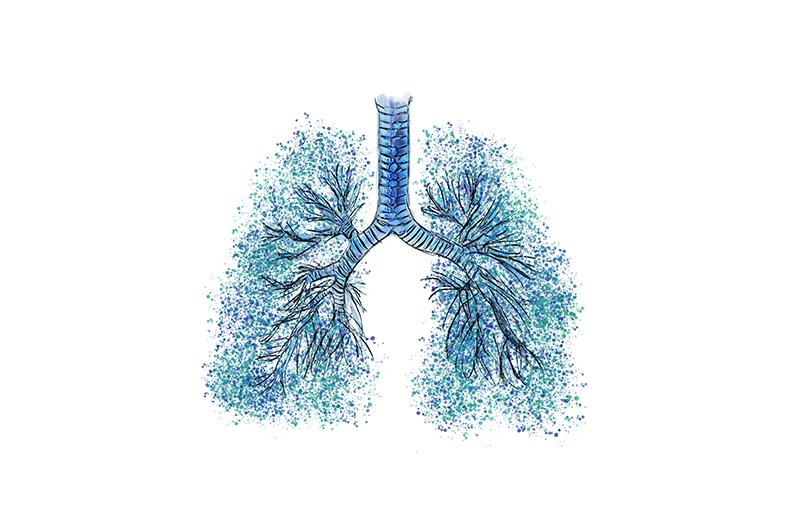NOTUS boosts dupilumab role for COPD, type 2 inflammation





The phase III NOTUS trial further validates the potential of the monoclonal antibody dupilumab in reducing exacerbations and improving lung function and quality of life (QoL) in patients with chronic obstructive pulmonary disease (COPD) and type 2 inflammation.
NOTUS aimed to replicate the findings from the BOREAS trial, which also showed the efficacy of dupilumab in this patient population, with a reduction in moderate-to-severe exacerbations and improvements in lung function, QoL, and symptoms. [N Engl J Med 2023;389:205-214]
“The study met its primary outcome,” said Dr Surya Bhatt from the University of Alabama at Birmingham in Alabama, US, at ATS 2024. Dupilumab cut the annualized rate of moderate-to-severe exacerbations by 34 percent vs placebo (0.86 vs 1.3; relative risk [RR], 0.664; p<0.001). Subgroup analysis consistently favoured dupilumab over placebo (RRs between 0.577 and 0.728).
Dupilumab also triumphed over placebo in terms of time to first moderate or severe exacerbation event (hazard ratio, 0.71; pnominal=0.002). [Bhatt, et al, ATS 2024]
Lung function, QoL
Lung function was also better with dupilumab vs placebo, as reflected by the change from baseline in prebronchodilator FEV1. The improvements were evident as early as week 2, further increasing by week 12 (least squares mean [LSM] difference, 0.082 L; p=0.001) and remaining stable until week 52 (LSM difference, 0.062 L; p=0.018). Subgroup analysis at week 12 showed a similar pattern.
Dupilumab also trumped placebo in terms of change in SGRQ* total score at week 52 (LSM mean difference, -3.4; pnominal=0.007). Of note, the improvements became evident as early as week 4. “A lower SGRQ score denotes better QoL,” noted Bhatt.
The same was true for the SGRQ QoL Domain scores at week 52 on post hoc analysis. These domains were activity (pnominal=0.028), impact (pnominal=0.02), and symptoms (pnominal=0.027).
Week 52 also saw a greater numerical improvement in E-RS:COPD** total score with dupilumab vs placebo (LSM mean difference, -0.6; pnominal=0.136).
Safety profile
Compared with the placebo arm, the dupilumab arm had similar incidences of severe (12.8 percent vs 13.4 percent) and serious TEAEs (13 percent vs 15.9 percent). The rates of TEAEs leading to permanent drug discontinuation (3.8 percent vs 2.6 percent) and death (2.6 percent vs 1.5 percent) were also not significantly different between arms.
“Dupilumab was well tolerated, and the safety profile is generally consistent with other dupilumab indications,” said Bhatt. The most common AEs were COVID-19 infection, headache, and COPD.
Preventing exacerbations is an important goal
COPD patients may experience frequent exacerbations and have a high symptom burden. About half of COPD patients continue to have flare-ups despite optimized treatment with inhaled triple therapy, Bhatt said.
“These exacerbations are not without consequence. They often lead to faster disease progression in the form of lung function decline, emphysema progression, and even mortality. [Hence,] prevention of exacerbations is a clinically important unmet need and an important target for novel COPD therapeutics,” he explained.
Type 2 inflammation in COPD is a common inflammatory profile. Interleukin(IL)-4 and IL-13 are key and central drivers of type 2 inflammation. “Dupilumab blocks the shared receptor component of IL-4 and IL-13,” Bhatt noted.
Bhatt and colleagues evaluated 935 patients (mean age 65 years, 68 percent men, 70 percent former smokers) with moderate-to-severe COPD and type 2 inflammation who were on background triple inhaler therapy (ICS + LAMA + LABA***) for at least 3 months with a stable dose for ≥1 month, or dual therapy (LABA + LAMA) if ICS was contraindicated. Participants were randomized 1:1 to either subcutaneous dupilumab 300 mg or placebo Q2W for 52 weeks.
“Dupilumab is the first biologic to significantly reduce moderate-to-severe exacerbations and improve lung function in patients with COPD and type 2 inflammation in two phase III trials,” Bhatt said.